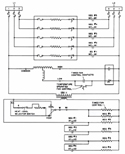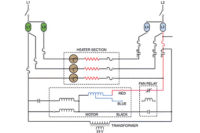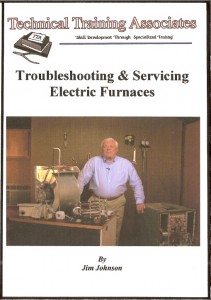Bob and Btu Buddy have gotten together for coffee to discuss the previous service call and some of the questions that came up. Btu Buddy said, “You asked about three things from the last service call: (1) Why check the amperage on both sides of an electric heater? (2) Why is the coil circuit on a sequencer often called a heater circuit? (3) Why do electric heat systems often use sequencers, rather than contactors? We will talk about them one at a time, and probably other questions will come up.”

Figure 1. This electric heat element looks like a spring and has a certain amount of spring tension to it. It is stretched between insulated terminals and insulators are applied all along the way. (Figures are from Practical Heating Technology, by William Johnson, published by Delmar Cengage Learning.) (©Delmar Cengage Learning.) (Click on the image for an enlarged view.)
Btu Buddy then answered question No. 1: “The electric heat coil, the part of the unit that gives off the heat energy, is a coil of metal wire. It is made of nickel-chromium and is called ni-chrome for short. This ni-chrome wire is typically coiled like a spring and stretched into a pattern for the heater circuit (Figure 1). Ni-chrome is used because it has a high resistance to electron flow, and when the electrons flow through it, a high heat is produced. Thus, the heat can be concentrated at the place where it can be controlled and utilized. Now back to the question about checking the current on both sides of the heater. Since the heater is typically wound like a spring, it has a certain amount of tension when it is stretched around the heater frame. If one of these coils were to break, it may slightly recoil and touch the frame of the heater. The frame of the heater is grounded, so now there can be a circuit to ground from one hot leg to ground. The heater will show current on one side and none on the other. This is a 115V circuit to ground. There may not be enough current flow moving through the heating element to blow a fuse or trip a breaker (Figure 2). Look at the drawing and notice that the sequencer only switches off one leg of power and the other leg is hot all of the time. This heater will not shut off and will continue to operate unless it pulls enough current to trip out a safety. If the heater fails in the middle of the coil, the amperage will be correct on one side of the heater and there will be none on the other side. It pays to always check current on both sides of any electric heater.”

Figure 2. This electric heat element is broken and one end is laying on the frame and grounded so current will continue to flow. Notice that the sequencer is on the other leg of power. The heater will operate on part voltage to ground, but may still give off enough heat to energize the temperature operated fan control (not shown in this diagram) and cause the fan to cycle on and off. (©Delmar Cengage Learning.) (Click on the image for an enlarged view.)
“Good question, Bob,” said Btu Buddy. “The furnace frame should be properly grounded and the technician should be safe. However, it is always good practice to check the frame of any electrical circuit to ground with a good meter before touching it. Especially under a house. You can do this by touching one meter lead to the frame and the other to a water pipe, or even stick it in the ground. If there is a voltage reading, shut off the power. You do not want to become part of a circuit to ground.”
Bob said, “The technician’s safety should be first.”
Btu Buddy then said, “Now for question No. 2 about the coil circuit in a sequencer. The sequencer uses a heater and a bi-metal element to move the contacts, not a magnetic coil. Many technicians use the terms heater circuit and coil circuit interchangeably. They both move the contacts, one by use of a bi-metal and heat and the other by magnetic force. Both of these devices must open and close the contacts with a snap action to prevent arcing. An arc of electrical energy is formed every time a circuit is closed to let electrical energy flow, or opened to interrupt the flow of electrical energy. It is particularly strong when the circuit is opened because energy is flowing and it wants to continue to flow, so an arc of electricity tries to keep the current flowing. It is minimized with snap or quick action.

Figure 3. This is the diagram from the last service call. Notice there are five sequencers and a temperature operated fan control. (©Delmar Cengage Learning.) (Click on the image for an enlarged view.)
“Time delay is another reason for using sequencers. A large amount of electrical and heat energy is produced in a very small area with electric heat of any kind. This energy should be brought on in stages to prevent surges from occurring in the flow of electric energy. On start-up, if all stages came on at the same time with a small electrical system, there would be a voltage drop until the system power source settled down. On shut-down, the opposite would occur, there would be a voltage spike for a short period of time. This can be leveled out by staging the heat both during start-up and shut-down. Sequencers handle this time delay staging easily during start-up and shut-down. Contactors would need an additional time delay for each contactor. This would be more expensive.”
“Boy, there is a lot to know about even the simplest system,” said Bob.
Btu Buddy responded, “Yes, there is. These systems have been built and used for many years and must be safe to the occupants and the service technicians that perform service on them. The technician must be familiar with them in order to perform safe service techniques.”
“Will I ever learn it all?” Bob asked.
“No,” said Btu Buddy, “but well founded basics will keep you safe and efficient while you are learning the techniques in the field.”
Publication date:02/22/2010







